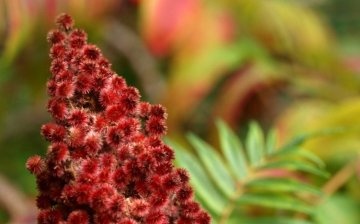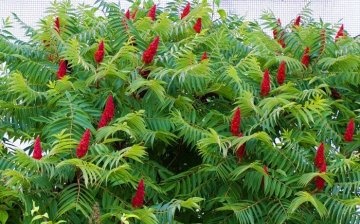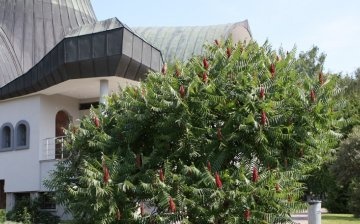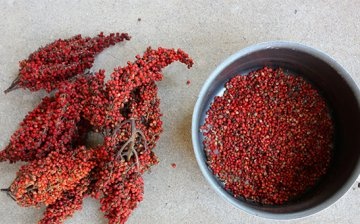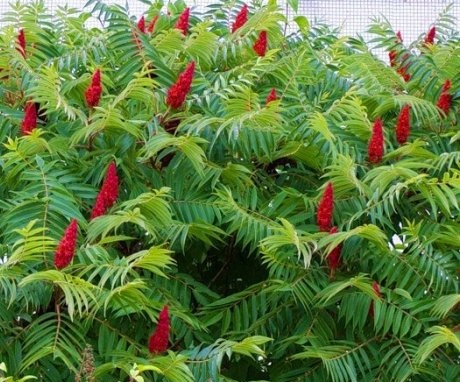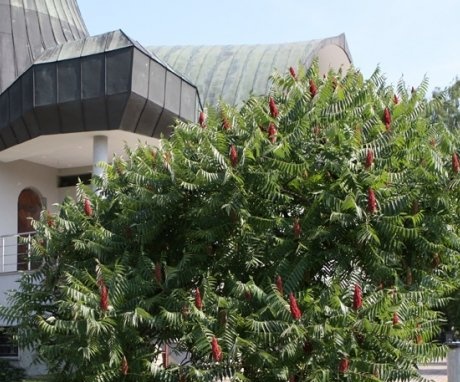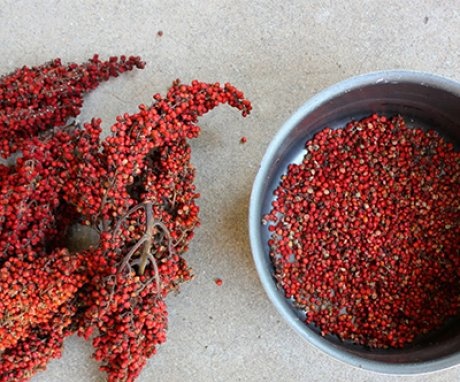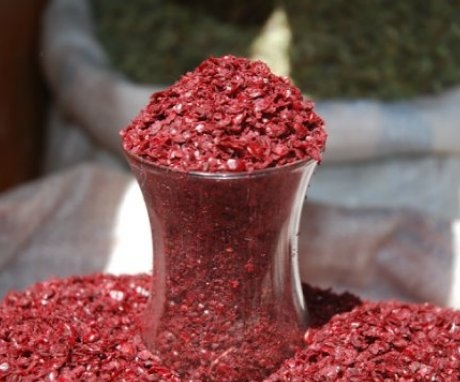Sumac plant: cultivation and use
Sumac or vinegar tree is an evergreen plant that can reach three meters in height. The appearance of sumach can remind everyone of the familiar rowan, especially the shape of the leaves - they are longish with teeth at the edges. This tree has over 150 different species.
Sumac blooms with fluffy white panicles. In their place, fruits subsequently appear and ripen, which are suitable for use as a spice. They are dried and ground into a powder that has a burgundy color and a sour smell.
Content:
- Tips for growing sumac
- How sumac is used in landscape design
- Useful properties and contraindications to the use of sumach fruits
- How sumac is used in cooking
Tips for growing sumac
Sumac grows almost everywhere, but the greatest variety of species can be found in South Africa.
Basic principles of planting and caring for sumac:
- The plant is unpretentious in the choice of soil, but the ideal substrate for it is: garden soil mixed with sand and humus.
- Sumakh loves light, so it is worth choosing the most illuminated area for it.
- The ideal age for planting sumach in open ground is two years, before that it should be grown in a planting container.
- Sumac can be planted in open ground in spring or autumn.
- You should plant two plants in one hole, as sumac is considered a dioecious plant.
- When planting, the roots must be properly straightened, then dug in with earth and watered.
- The distance between plants should not be less than two meters.
- You can dig limiters into the ground that will restrain the rapidly developing root system.
- After landing, it will be useful mulching peat or sawdust.
Sumac begins to bloom from the fourth or fifth year of life. Sumac tolerates heat well; an adult tree requires watering only during drought periods. Young plants require more frequent watering and feeding mineral fertilizers.
Sumakh is a southern plant and is difficult to tolerate winter frosts.
It is important to ensure that the tree does not suffer from frostbite and does not break under the weight of the snow. If the sumac is still frostbite, then in the spring it is necessary to cut off the affected branches.
Sumac is propagated by seeds and root division. Seed propagation is a rather difficult process, since the germination rate of this method is very low, and rooting is weak. In order to prepare the seeds for planting, they should be soaked for an hour in sulfuric acid. During the soaking process, the shell is broken. Seeds sprout, as a rule, one month after planting.
How sumac is used in landscape design
Sumac is often used in landscape design because of its unpretentious care. The most common decisions in which they prefer to plant this plant:
- Gardens that do not require special care (sumac is able to grow independently and in a very short time).
- Securing uneven areas (slopes and ravines).
- On lawns to destroy various weeds (sumac has an aggressive and actively developing root system that engulfs nearby plants).
- As hedge, or along the fence.
- In compositions that imply a contrast of colors (after all, in the fall, sumac leaves become crimson).
The only difficulty in growing sumach is the constant struggle with numerous shoots, because sumac can fill any space, even that is not intended for it.
Useful properties and contraindications to the use of sumach fruits
Sumach spice is appreciated both in cooking and in folk medicine:
- Sumac is an antioxidant, as it contains oils, acids and tannins.
- Sumach leaves have anti-inflammatory and wound healing effects.
Sumy is used for:
- Colds
- Rheumatism
- Gout
- Dysentery and various poisonings
- Neoplasms
- Cleansing the body of toxins
- Violations of the gastrointestinal tract
- Diabetes
- Increased fatigue
However, even with its many advantages, sumy also has contraindications:
- Sumac should not be consumed in the presence of ulcers and acute gastritis.
- Also, it should not be used for thrombosis and blood clotting problems.
- You should be very careful when using sumach in case of impaired carbohydrate metabolism.
How sumac is used in cooking
Sumac spice has a spicy, sour-astringent taste. It is considered a very valuable ingredient in cooking, as it is a natural preservative and helps to keep food fresh for a longer period. Sumac is quite often used in oriental cuisine.
In what dishes it is customary to use sumy:
- Most often, the spice is added when cooking kebabs and barbecues. The combination of sumach with lamb turns out to be especially good. It softens the meat fibers, making the dish soft and tender.
- Sumac is also added when cooking fish. However, it is important to consider that the bright ruby color of the spice can color the rest of the food.
- Sumac is often added to legumes and rice dishes. They are very fond of using it in the preparation of pilaf.
- Pickled onions with the addition of sumach acquire an original color and taste.
- This spice is also often used to add sourness to baked goods.
- When preparing drinks, sumac can be used as a substitute for citric acid.
- Sumac goes well with other spices, especially sesame seeds.
In order to determine the quality of a spice, just look at its color. It should not be dull, as this indicates an expired product. The shelf life of sumach, as a rule, does not exceed a year. At the same time, it should be stored in a tightly closed container, away from sunlight. If you overdo it and add too much spice, the dish will spoil, acquiring a sour taste. It is not for nothing that sumac is called the vinegar tree, its fruits contain so much acid that it is quite capable of replacing vinegar and lemon juice.
More information can be found in the video:



